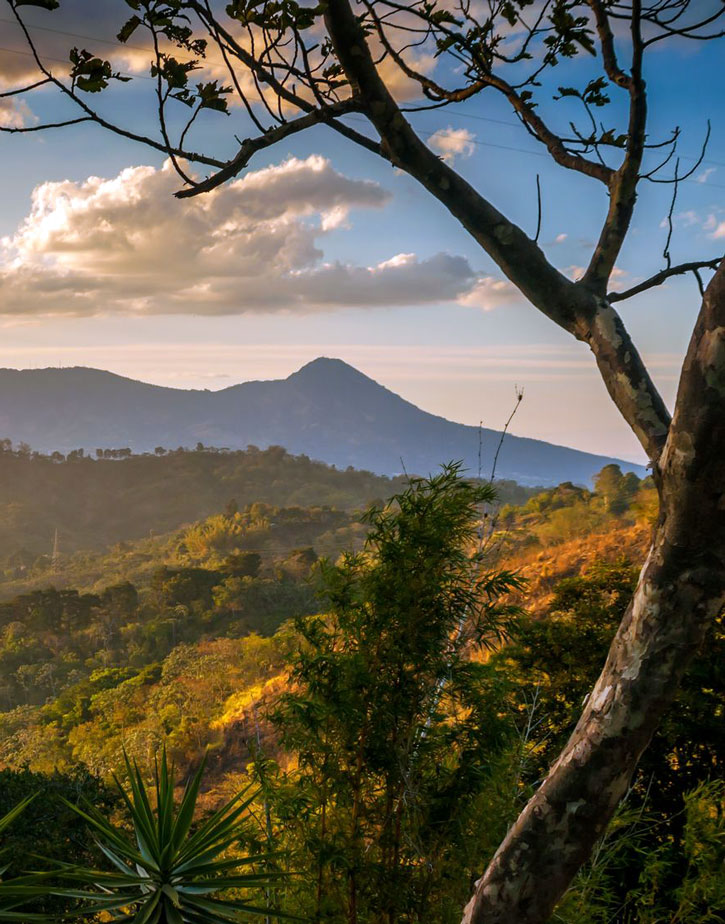Volcano hikes, national parks teeming with birds and butterflies, and a rugged Pacific coastline dotted with secluded getaways make this country an outdoor enthusiast’s dream. But by far, El Salvador’s most valuable asset is its people. Hard-working and fast-talking, Salvadorans always have time to help someone in need. The country seems to run on the perfect balance of play and productivity. Perhaps it is the many and varied hardships the people of this land have endured that has taught them that life is too short to be taken too seriously. If you ask a Salvadoran where something is, you may be offered a ride, asked to join a meal, then be offered half the plate. And if somebody invites you over to their home, chances are you will have a forged a friendship for life.

The mountainous landscape of Panchimalco near San Salvador. Photo © milosk/123rf.
The land of El Salvador is as colorful as the people. The abundance of volcanoes lends it a mythical appeal; flowering trees pepper the landscape with orange, lavender, and fuchsia hues; and the diverse coastline offers huge waves, surreal estuaries, and expansive white-sand beaches. El Salvador is the smallest country in Central America, making it possible to take a morning hike in the cool northern mountains, eat fresh seafood on the beach for lunch, and then shimmy the night away at a salsa bar in San Salvador.
Unfortunately, many people exploring Central America opt out of El Salvador, scared off by reports of violence and crime. Yes, gang activity is high, but it’s also localized in terms of where and who is targeted. Incidents involving visitors are extremely rare. The El Salvador you hear about in the news and the El Salvador you are about to discover are two very different places. Leave your preconceptions at the border, expect the unexpected, and prepare to be pleasantly surprised.
There are two seasons in El Salvador—the rainy season and the dry season. Rain falls from June to November, and usually during the night. The ideal time to go is right after the rainy season in December-January when things are still lush and green. The best time to go surfing is March to October.
The high season is considered Semana Santa (the week leading up to Easter), the month of August (when there are school holidays and San Salvador celebrates its Fiestas Agostinas), and December, when there are extended holidays for Christmas.
Travelers to El Salvador must have a passport that is valid for at least six months beyond the date of entry. A visa is not required to enter El Salvador, but a tourist card, which costs $10, must be purchased upon entry at Aeropuerto Internacional Comalapa or through any of the four land-border entry points. When you buy the tourist card, you will be given a receipt to keep with your passport. You will not be required to pay it again if you exit and reenter El Salvador, as long as you have your receipt and your tourist card remains valid.
Although no immunizations are required to enter El Salvador (aside from yellow fever, if you are arriving directly from a tropical region), visitors should make sure their routine immunizations are up to date. In addition, dengue fever (for which there is no vaccine) has become quite prevalent in the last few years, so it is advised to take extra precaution when it comes to avoiding mosquitoes.
El Salvador has one international airport, Aeropuerto Internacional Comalapa, and a very comprehensive and economical bus system within the country, but riding on old American school buses might not suit everyone’s tastes. Hiring a private taxi to get around is an option but is quite costly. It’s cheaper to rent a car, and El Salvador has an excellent road system.
Excerpted from the First Edition of Moon El Salvador.